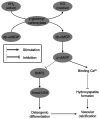Role of vitamins beyond vitamin D3 in bone health and osteoporosis (Review)
- PMID: 38063255
- PMCID: PMC10712697
- DOI: 10.3892/ijmm.2023.5333
Role of vitamins beyond vitamin D3 in bone health and osteoporosis (Review)
Abstract
The objective of the present review was to summarize the molecular mechanisms associated with the effects of the vitamins A, C, E and K, and group B vitamins on bone and their potential roles in the development of osteoporosis. Epidemiological findings have demonstrated an association between vitamin deficiency and a higher risk of developing osteoporosis; vitamins are positively related to bone health upon their intake at the physiological range. Excessive vitamin intake can also adversely affect bone formation, as clearly demonstrated for vitamin A. Vitamins E (tocopherols and tocotrienols), K2 (menaquinones 4 and 7) and C have also been shown to promote osteoblast development through bone morphogenetic protein (BMP)/Smad and Wnt/β‑catenin signaling, as well as the TGFβ/Smad pathway (α‑tocopherol). Vitamin A metabolite (all‑trans retinoic acid) exerts both inhibitory and stimulatory effects on BMP‑ and Wnt/β‑catenin‑mediated osteogenesis at the nanomolar and micromolar range, respectively. Certain vitamins significantly reduce receptor activator of nuclear factor kappa‑B ligand (RANKL) production and RANKL/RANK signaling, while increasing the level of osteoprotegerin (OPG), thus reducing the RANKL/OPG ratio and exerting anti‑osteoclastogenic effects. Ascorbic acid can both promote and inhibit RANKL signaling, being essential for osteoclastogenesis. Vitamin K2 has also been shown to prevent vascular calcification by activating matrix Gla protein through its carboxylation. Therefore, the maintenance of a physiological intake of vitamins should be considered as a nutritional strategy for the prevention of osteoporosis.
Keywords: menaquinone; osteogenesis; osteoporosis; tocopherol; vitamins.
Conflict of interest statement
DAS is the Editor-in-Chief for the journal, but had no personal involvement in the reviewing process, or any influence in terms of adjudicating on the final decision, for this article. The other authors declare that they have no competing interests.
Figures




References
-
- Lorentzon M, Cummings SR. Osteoporosis: The evolution of a diagnosis. J Intern Med. 2015;277:650–661. - PubMed
-
- Xiao PL, Cui AY, Hsu CJ, Peng R, Jiang N, Xu XH, Ma YG, Liu D, Lu HD. Global, regional prevalence, and risk factors of osteoporosis according to the World Health Organization diagnostic criteria: A systematic review and meta-analysis. Osteoporos Int. 2022;33:2137–2153. - PubMed
Publication types
MeSH terms
Substances
LinkOut - more resources
Full Text Sources
Medical

